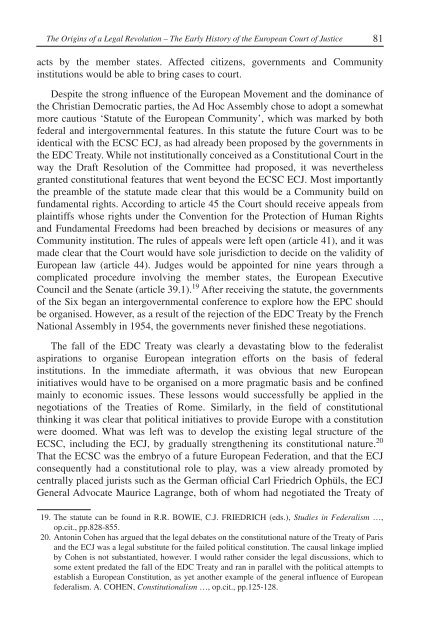2008, Volume 14, N°2 - Centre d'études et de recherches ...
2008, Volume 14, N°2 - Centre d'études et de recherches ...
2008, Volume 14, N°2 - Centre d'études et de recherches ...
Create successful ePaper yourself
Turn your PDF publications into a flip-book with our unique Google optimized e-Paper software.
The Origins of a Legal Revolution – The Early History of the European Court of Justice 81<br />
acts by the member states. Affected citizens, governments and Community<br />
institutions would be able to bring cases to court.<br />
Despite the strong influence of the European Movement and the dominance of<br />
the Christian Democratic parties, the Ad Hoc Assembly chose to adopt a somewhat<br />
more cautious ‘Statute of the European Community’, which was marked by both<br />
fe<strong>de</strong>ral and intergovernmental features. In this statute the future Court was to be<br />
i<strong>de</strong>ntical with the ECSC ECJ, as had already been proposed by the governments in<br />
the EDC Treaty. While not institutionally conceived as a Constitutional Court in the<br />
way the Draft Resolution of the Committee had proposed, it was nevertheless<br />
granted constitutional features that went beyond the ECSC ECJ. Most importantly<br />
the preamble of the statute ma<strong>de</strong> clear that this would be a Community build on<br />
fundamental rights. According to article 45 the Court should receive appeals from<br />
plaintiffs whose rights un<strong>de</strong>r the Convention for the Protection of Human Rights<br />
and Fundamental Freedoms had been breached by <strong>de</strong>cisions or measures of any<br />
Community institution. The rules of appeals were left open (article 41), and it was<br />
ma<strong>de</strong> clear that the Court would have sole jurisdiction to <strong>de</strong>ci<strong>de</strong> on the validity of<br />
European law (article 44). Judges would be appointed for nine years through a<br />
complicated procedure involving the member states, the European Executive<br />
Council and the Senate (article 39.1). 19 After receiving the statute, the governments<br />
of the Six began an intergovernmental conference to explore how the EPC should<br />
be organised. However, as a result of the rejection of the EDC Treaty by the French<br />
National Assembly in 1954, the governments never finished these negotiations.<br />
The fall of the EDC Treaty was clearly a <strong>de</strong>vastating blow to the fe<strong>de</strong>ralist<br />
aspirations to organise European integration efforts on the basis of fe<strong>de</strong>ral<br />
institutions. In the immediate aftermath, it was obvious that new European<br />
initiatives would have to be organised on a more pragmatic basis and be confined<br />
mainly to economic issues. These lessons would successfully be applied in the<br />
negotiations of the Treaties of Rome. Similarly, in the field of constitutional<br />
thinking it was clear that political initiatives to provi<strong>de</strong> Europe with a constitution<br />
were doomed. What was left was to <strong>de</strong>velop the existing legal structure of the<br />
ECSC, including the ECJ, by gradually strengthening its constitutional nature. 20<br />
That the ECSC was the embryo of a future European Fe<strong>de</strong>ration, and that the ECJ<br />
consequently had a constitutional role to play, was a view already promoted by<br />
centrally placed jurists such as the German official Carl Friedrich Ophüls, the ECJ<br />
General Advocate Maurice Lagrange, both of whom had negotiated the Treaty of<br />
19. The statute can be found in R.R. BOWIE, C.J. FRIEDRICH (eds.), Studies in Fe<strong>de</strong>ralism …,<br />
op.cit., pp.828-855.<br />
20. Antonin Cohen has argued that the legal <strong>de</strong>bates on the constitutional nature of the Treaty of Paris<br />
and the ECJ was a legal substitute for the failed political constitution. The causal linkage implied<br />
by Cohen is not substantiated, however. I would rather consi<strong>de</strong>r the legal discussions, which to<br />
some extent predated the fall of the EDC Treaty and ran in parallel with the political attempts to<br />
establish a European Constitution, as y<strong>et</strong> another example of the general influence of European<br />
fe<strong>de</strong>ralism. A. COHEN, Constitutionalism …, op.cit., pp.125-128.

















